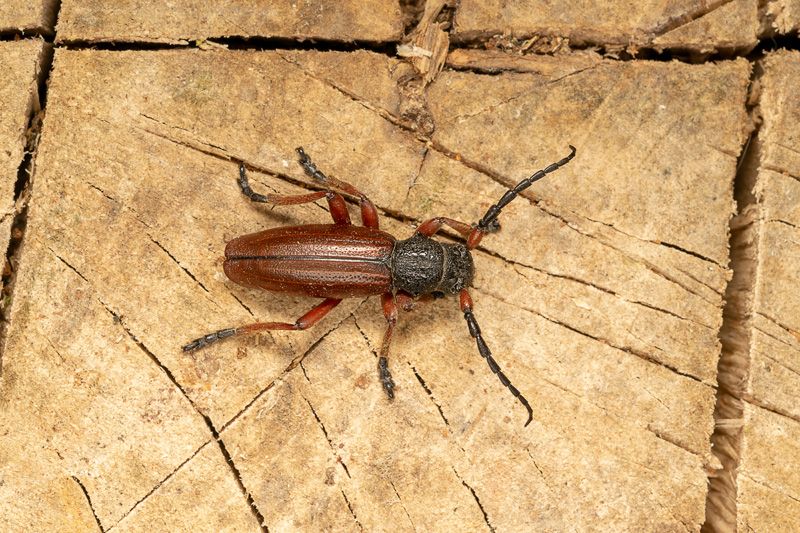
Brown Spruce Longhorn Beetle – Haylyomorpha halys
Brown Spruce Longhorn Beetle – Tetropium fuscum
Description of Insect:
The brown spruce longhorn beetle (Tetropium fuscum) is an invasive wood-boring insect native to Europe, Western Siberia, and Japan. This beetle is a member of the Cerambycidae family, characterized by their elongated, flattened bodies and long antennae. Adults are dark brown to red, with a slender, cylindrical shape measuring approximately 10-15 mm in length. Their antennae are almost half their body length, a distinguishing feature of the species.
The brown spruce longhorn beetle larvae are primarily white with a red to brown head, growing up to 28 mm long. It mainly targets spruce trees, but fir, pines, and larches are also at risk; making it a significant threat to coniferous forests. Its larvae bore into the inner bark and sapwood, disrupting the flow of nutrients and water within the tree. This feeding behavior weakens and eventually kills the host tree, leaving behind visible galleries in the wood. The galleries are filled with frass and chewed wood, a common indication of the infestation.
Adults are most active during late spring or early summer, emerging to mate and lay eggs on susceptible trees. The beetle thrives in stressed or weakened trees, causing trees to die within 1 to 5 years. It can also attack healthy trees, exacerbating its impact on forest ecosystems.
Life cycle of Brown Spruce Longhorn Beetle
The life cycle of the brown spruce longhorn beetle consists of four stages: egg, larva, pupa, and adult; and takes 1 year to complete. Females lay greenish-white eggs in crevices of the bark on stressed or dying spruce trees. The females eggs in clusters of 1 to 10, with the eggs hatching within 7-14 days.
Upon hatching, the larvae burrow into the bark and begin feeding on the phloem and sapwood. There are six larval instars, and the larval stage lasts 1-2 years, depending on environmental conditions such as temperature and tree health. During this time, the larvae create extensive galleries beneath the bark, which disrupt the tree’s nutrient flow and leave white resin, or weeping sap, running down the trunk.
After completing their development, the larvae pupate within the tree. The following spring, adult beetles emerge through round exit holes measuring 4-6 mm in diameter. Adults live for 2 weeks, during which they mate and continue the cycle. They can fly several kilometers, aiding the spread.
Damage they cause:
The brown spruce longhorn beetle is a highly destructive pest with significant ecological, economic, and aesthetic impacts.
- Ecological Impact: This beetle poses a severe threat to coniferous forests, particularly those dominated by spruce species. By targeting weakened and stressed trees, it accelerates the decline of already vulnerable stands, reducing forest resilience and altering ecosystem dynamics.
- Economic Impact: The brown spruce longhorn beetle has significant economic implications, particularly for the forestry and timber industries. Infestations reduce the quality and commercial value of spruce wood. The beetle’s feeding leaves behind galleries and exit holes that compromise the structural integrity and aesthetic quality of the lumber.
- Aesthetic Impact: In urban and recreational areas, the brown spruce longhorn beetle affects the visual appeal of landscapes by killing ornamental and mature spruce trees. Dead or dying trees detract from the natural beauty of parks, and forested areas, impacting aesthetic and property value.
